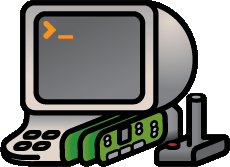|
Possible subjects for the Platform Studies series include chipsets and hardware; general-purpose computers and their operating systems;
specialized microcomputers, such as videogame consoles; programming languages; and software and programming environments.
The following platforms suggest examples for books in the series. These are only
suggestions; authors are invited to propose books on any kind of computing system that has supported significant new media work.
1960: PLATO
This system, sometimes said to be named Programmed Logic for Automated
Teaching Operations, was an early educational computing system, developed
for more than a decade an a half at the University of Illinois. Its TUTOR
programming language, developed in 1967 for coding up computer aided
instruction modules, allowed for the development of online games as well.
These included massively multiplayer games and a flight simulator. PLATO
was a platform for an early online community, offering discussion boards
and other facilities, and so became an influential digital communications
platform as well as a computing platform.
1977: The Atari Video Computer System (Atari 2600)
The Atari VCS (renamed the Atari 2600 in 1982) was the first successful
cartridge-based video game console. Its massive library of games includes
titles that inspired whole video game genres: Adventure (the graphical
adventure); Pitfall (the action-adventure); and River Raid (the
vertical scroller). Important elements of the platform include the Atari
VCS's 6507 processor, its Television Interface Adapter (TIA), its
interchangeable ROM cartridges, and a variety of 8-pin controllers. The
system was not the easiest to program and was built for two-player,
Pong-like gameplay, but the ingenuity of developers led to genre
innovations, arcade ports, and many new directions over the long life of
the system.
1990: The Multimedia Personal Computer (MPC)
In 1990 the Multimedia PC Marketing Council published a specification,
according to Microsoft, "to encourage the adoption of a standard
multimedia computing platform." It defined a system with a 16 MHz 386SX,
30 Mb hard disk, 2 Mb RAM, single-speed CD-ROM, VGA, 3 1/2 inch floppy
disk, sound card, mouse, joystick, and Microsoft Windows 3.0 with
Multimedia Extensions. While industry-defined, this type of platform
definition was quite different from the production of a proprietary video
game console. Many early CD-ROMs, whether for gaming, education,
reference, or other purposes, assumed the MPC platform. The MPC definition
helped to bring modern-day multimedia to home users.
1995: Java
Java is an object-oriented programming language, C-like in its syntax, and
a virtual machine. The Java VM allows code to run independent of
particular hardware and operating systems. Java is an intriguing platform
on many levels, because it is all-software, because of its course from a
proprietary product to a free/open-source code base, and because of its
widespread use in business and education contexts as well as creative
ones. It has been widely used on the Web for networked and stand-alone
games and projects. Processing, a programming language meant to serve as
an electronic sketchbook, is a platform for creative production that is
built on top of Java.
2006: Wii
The Nintendo system that was code-named "Revolution" offers less raw
processing power than other consoles of its generation. It has an
innovative interface scheme, however, recalling the way that the
stylus-equipped Nintendo DS relates to the Sony PSP. The controllers use
accelerometers and radio frequency communication with the console base,
allowing for input gestures that imitate in-game action. Among other
things, this suggests to developers that they rework standard games being
ported to the Wii to make use of this new capability. Interestingly, the
Wii's Virtual Console also allows fluid emulation of many earlier
platforms.
|



